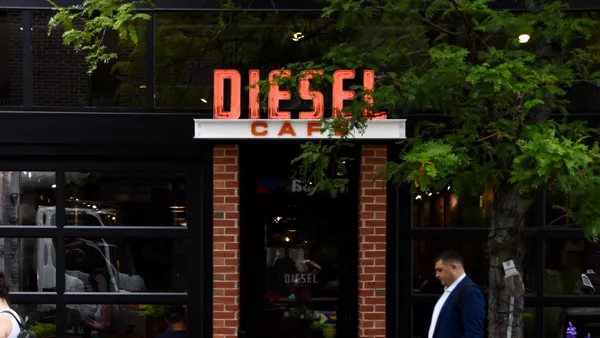Dive Brief:
- New research from Gusto predicts that an impending winter slowdown has the potential to erase 2 million in job gains from September and August, or about $190 billion in economic activity, with retail trade and leisure and hospitality industries impacted the most. More aggressive estimates show that job losses could be as high as 2.8 million.
- Those modest summer gains came from these industries adjusting to restrictions with efforts like adding al fresco dining, according to Gusto. Using this methodology, the company's job-loss estimates assumes these adjustments are not sustainable in colder weather.
- Mid-sized cities and smaller cities (with populations of 200,000 or less) will be affected the most, according to the research. The report specifically predicts a looming crisis in the North, from New England to the Pacific Northwest, with some extension into the South. Markets where average temperature drops to below 50 degrees by November, an area that represented about 45% of total private employment in March, are classified as "at risk." Markets including Chicago, Colorado and Washington, D.C. have created programs or grants to help restaurants maintain outdoor dining in cold weather, but these efforts may not be enough to stem closures.
Dive Insight:
Gusto's report notes that other factors besides adjusting to outdoor dining — including the lifting of state and local shutdown orders — haven't contributed as much to restaurant's economic recovery, which is interesting since most jurisdictions have reopened dining rooms at least partially after months-long closures.
Not only is the impending cold weather going to be a challenge, so too is consumer anxiety about eating indoors if restaurants are forced to rely mostly on that channel. The CDC released a September report that found dining out increases COVID-19 risk more than other activities.
As such, restaurants across the country are scrambling to add heaters, tents and other features to maintain some outdoor dining capacity while also adding safety features to their indoor dining rooms, like Plexiglass dividers. Some restaurants are getting more creative with their solutions — one restaurant in Maine added heated igloo tents, for example. These types of enclosures are becoming popular as restaurants brace for the start of winter, but do result in costs as high as $1,400 per tent.
Outdoor dining has been a lifeline for restaurants amid the pandemic. According to a new audit, The Restaurant Industry in New York City: Tracking the Recovery, restaurant employment in the city fell to about 91,000 jobs in April after reaching a record-high of 317,800 in 2019. However, the industry recovered to about 174,000 by August — a number achieved with the help off outdoor dining thanks to the city's Open Restaurants and Open Streets program. The program allows many city blocks to close off to traffic to allow restaurants to expand outdoor dining. Mayor Bill de Blasio has since made that program permanent and year around, and said the program has saved almost 100,000 jobs.
Still, a vast majority of New York's hospitality businesses couldn't afford to pay full rent in August, reflecting that outdoor dining isn't necessarily an end-all solution, particularly as temperatures in the city average less than 40 degrees in January, and that restaurant jobs are still very much at risk.
As the second largest private-sector employer in the country, the restaurant industry's job losses have a significant impact on the general unemployment rate, which now stands at about 8%, from about 14% in April. One likely scenario is that job recovery varies by state. Over the summer, for example, southern states contending with rising coronavirus cases experienced more restaurant losses than other states. That trend could shift to colder weather states this winter.
There are other solutions, like DoorDash's cold weather grants, available to help small restaurants winterize their establishments with equipment like heaters, tents and lighting. This may keep some outdoor dining activity going and keep employees working, but it might not make a material difference when the rent is due. These efforts are also confined to certain markets and qualifying restaurants. There is also the possibility that dine-in restrictions could return in the wake of rising COVID-19 cases, which are pushing the U.S. barrels toward a new infection peak.













